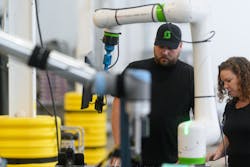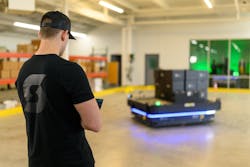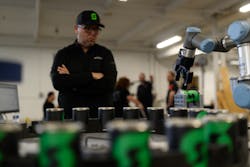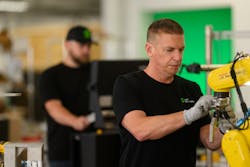Customer-driven Gray Solutions focuses on creative applications to drive production quality and speed
All 275 team members at Gray Solutions are called “solutioneers,” explains Walker Mattox, CEO. “While many have an engineering background, every solutioneer drives effective and efficient solutions for our customer,” he says. The system integrator, based in Lexington, Kentucky, works primarily with customers in the food and beverage, consumer packaged good (CPG), life sciences and chemical industries, mostly in the United States, but also Canada, Mexico and Ireland. “We work both in the physical and digital environments developing creative solutions that help our customers overcome challenges and make advancements.”
For customers in those industries, developing systems to manufacture new products faster and more efficiently is a major focus of Gray Solutions’ work. “Speed to market has been and will continue to be a major area of focus for our customers and that is truly end to end, from getting the equipment installed and automated to product on the shelves,” Mattox says.
In addition to automation and controls consulting, design and integration, Gray Solutions consults on technology platforms and implementation, offers procurement services of equipment and control panels, and provides process design services that help customers visualize and lay out their production lines. Gray Solutions is also a member of the Control System Integrators Association (CSIA).
Bridging protocols: the importance of open communication standards
In the hunt for the best equipment and software, manufacturers are becoming more vendor-agnostic, Mattox says. “From a technology standpoint, there’s an increasing need for open communication standards,” he adds. “The underlying products, while having different control architectures, must be able to seamlessly work together.”
Sometimes the system integrator does find projects locked into a certain brand when expanding on an existing system, which may require third-party translation devices, says Paul Ericksen, senior automation engineer at Gray Solutions. “Utilizing third-party solutions in itself introduces problems such as increased complexity, additional points of failure, requiring maintenance and engineering staff to learn a different system, and keeping additional spare parts in inventory,” he adds.
Third-party applications can be used to bridge between protocols, or a middleware or custom application can be used to bridge or translate messages, explains Brent Humphreys, principal, digital strategist at Gray Solutions. “We need open communication standards that are fast and secure,” he says. “The important part is to carefully plan the handshake between systems and meaning of each field to ensure that both sides of the integration have a clear view of the communication status.”
Gray Solutions was named as a System Integrator of the Year by Rockwell Automation and maintains a strong relationship in the partner network. “However, we believe it’s vitally important to be brand-agnostic when it comes to our customers. We collaborate with our customers to determine what is best for their needs on a project-by-project basis,” Mattox says.
Digital-twin tools for spatial planning, live modeling and facility layout
Solutioneers at Gray Solutions have been “obsessed” with the potential of digital twins, Mattox says. The team evaluated a number of tools and locked in on Emulate3D, which it uses as its primary simulation tool.
“Emulating solutions for our customers prior to producing them in real life allows us to proactively catch design issues before implementation, increasing the project's overall efficiency and ultimately delivering a better result for our customer,” Mattox says.
Rick Graff, senior application engineer at Gray Solutions, has used Emulate3D on many customer projects:
• To retrofit existing designs—Space is a finite resource, especially when adding on to existing operations. Gray Solutions performs to-scale spatial planning upfront to ensure all the pieces of the production puzzle fit snuggly in the space available.
• For emulation modeling—By modeling live processes, such as packing bags of fresh produce, it can pre-determine equipment needs and throughput rates, optimize design and virtually test sequential controls long before large capital investments are made.
Data to power artificial intelligence
At the center of its customers’ operations lies data, and Gray Solutions views data as an essential utility for manufacturers, like electricity or compressed air. “Gray Solutions is helping companies organize their data by providing data assessments for structure, data collection/integration and data quality,” says Greg Powers, vice president of cool stuff at Gray Solutions.
“Using proven vision AI technology, manufacturers can scale production, reduce waste and adapt to workforce changes, while achieving even higher levels of quality control,” Powers adds.
“It’s also important to understand that, while AI will absolutely transform this industry, leveraging any kind of AI or machine learning (ML) without a robust data library is impossible,” explains Mattox. “Most manufacturers need to focus on data collection and robust security to lay the foundation for the inevitable adoption of artificial intelligence and machine learning.”
Cobot innovation for production quality
One Gray Solutions’ customer, a pet-food manufacturer, deploys cobots as part of its food-inspection process. “Inspecting variables like moisture content ensures less scrap as product is being produced,” says Dean Elkins, senior director of advanced automation at Gray Solutions. “With less scrap comes less energy required for rework. The cobots themselves can run on 110-V power with significantly lower kiloVolt Amp (kVA) requirements than larger industrial robots, which equates to using less power.” Remote capability to monitor cobots via cellphone or personal computer (PC) means plant personnel does not need to travel on-site to monitor equipment or production rates, he adds.
“When you get a solutioneer focused on your problem, they’re guaranteed to bring one thing to the table—curiosity,” Mattox says. “Our innate curiosity as a team allows us to uncover innovative solutions to complex problems every day.”









